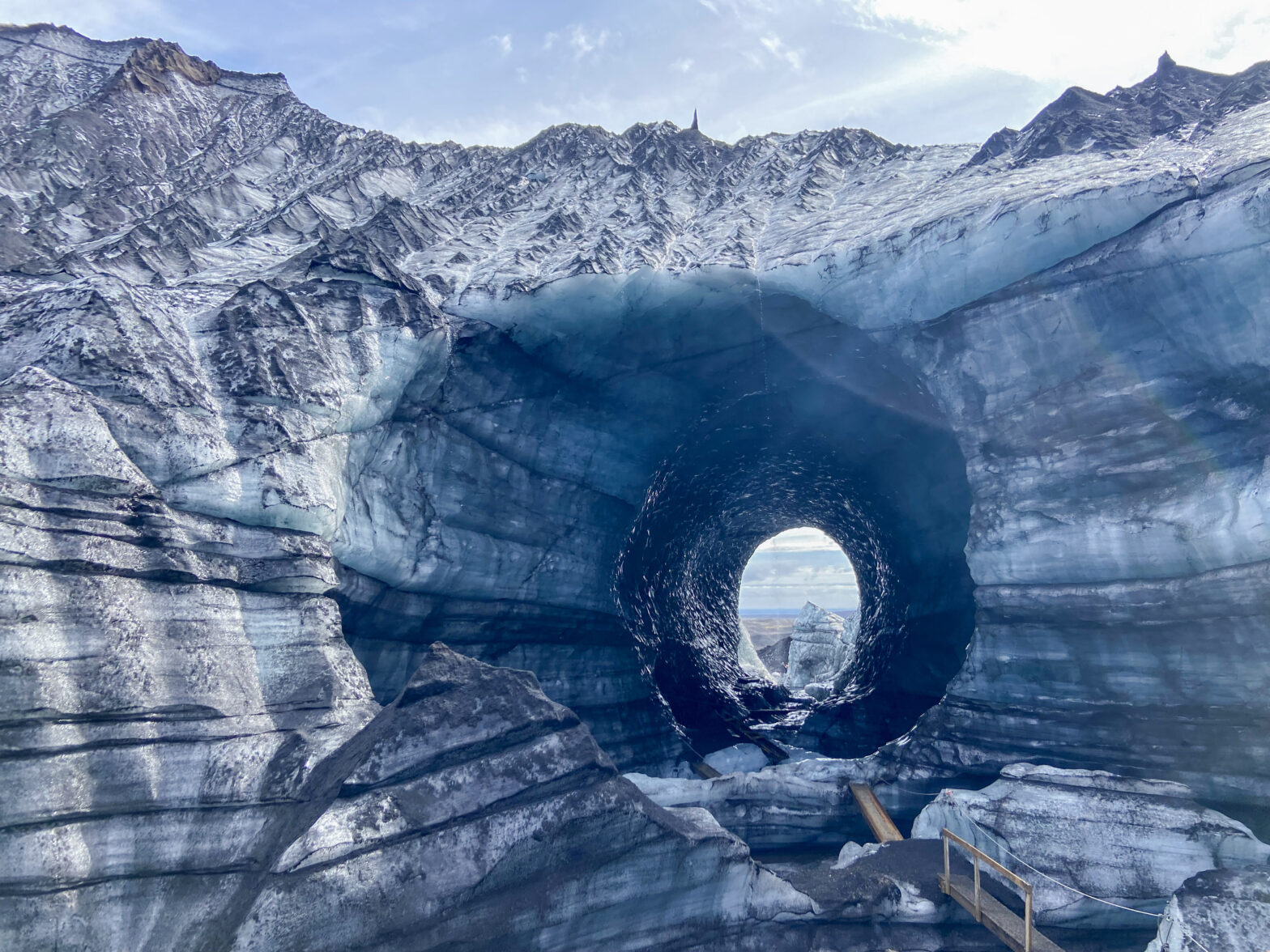Believe it or not, there is ice on the island known as Iceland. This may come as a shock, I know. While glaciers are in retreat worldwide, it’s going to take a couple of centuries to melt some of the great icecaps on the southern end of Iceland. The locals have long made a tourist industry out of the big old hunks of ice that grace their high terrain, some of which have spent hundreds of years getting down to sea level along the south coast. The town of Vik makes for a great staging point, as it sits at the foot of the great Mýrdalsjökull ice cap. From there, several outlet glaciers are easily accessible for recreational activities. I think my blog has made it clear over the years that I prioritize seeing the glaciers before they disappear. Our honeymoon was a perfect time to not just see, but explore those glaciers. And what better way to do so than to go on an ice cave tour?
Our awesome trip planner booked us an ice cave tour for July 28, our first of two full days in Vik. The meet-up spot was listed as the parking lot behind Icewear, the retail giant in Iceland. The tour company said they’d pick us up in a Jeep van. But of course there were several tours bound for several very cool things with several large vehicles, so it took a few apprehensive minutes and the assistance of some very nice German guys in our group to confidently step into our vehicle. And maybe “confidently” is the wrong word. Maybe “awkwardly sidle into the very backseat of a 5-tiered van and squish in 3-wide despite the fact that the two of us were wearing the very apex of winter outdoor gear on a 50-degree day” fits the bill better.
So yeah, it didn’t take very long before I was sweating in the back seat profusely. The driver cruised along the Ring Road eastward past another one of those glacial outwash rivers that were so pretty. It hadn’t been more than a few minutes before the driver pulled left off of the highway and began to jounce down a dirt road through a field. And the word “road” became more and more of a misnomer. Now it was more like a dirt track, and now it was more like a dirt field, and now we were rounding a big green mountain onto an alien landscape of all-black soil. The driver let us all out of the cramped vehicle and into the sunny Icelandic sky. In the distance, I could see it: a massive ice sheet, literally blanketing the top of a mountain in the distance. Even from several kilometers away I could see a massive waterfall as this ice sheet abutted the edge of the mountain.
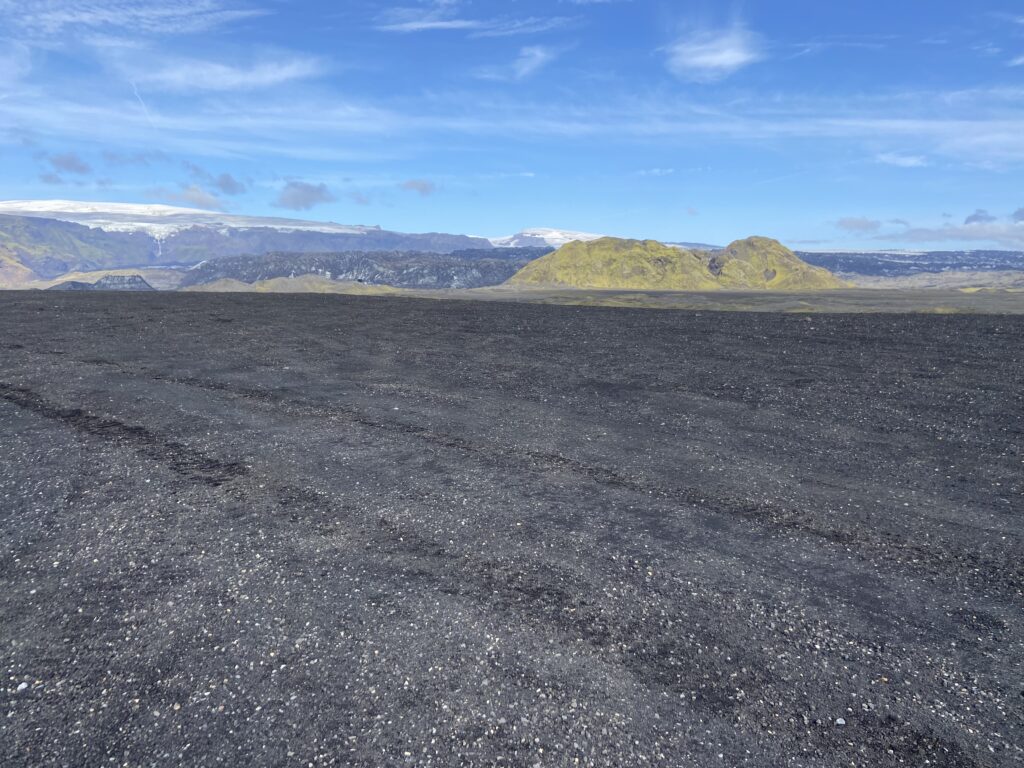
It took me a second to adjust to my surroundings. First of all, no, that isn’t just a bunch of asphalt sitting in the foreground. That’s actually a bunch of rocky soil. And in between me and the massive icecap was a craggy terrain of white and black that was a bit hard to discern. Elizabeth figured it out first – that’s the Katla Glacier, our ultimate stopping point.
But first, our guide showed us the floodplain we were standing on. It turns out that Katla isn’t just a glacier – like a lot of Iceland, it’s a glacier sitting on top of an active glacier. And not just an active volcano, but one that likes to do cataclysmic eruptions every few years. When that happens, the glacier has a tendency to get moved really fast and also melt really fast. In other words, you get a giant glacial flood washing out to the sea. Everything around us had been wiped smooth by those floods, leaving only the sturdiest mountains poking up through the flatness. And the black sand is heavily imbibed with ash from Katla’s eruptions. It makes for a lunar landscape that our guide was happy to inform us had been the setting for many, many movies.

And then it was time to get back in the van for the big plunge off of this floodplain and into the river valley itself. Let me tell you – that would be one heck of a place to take a sled in the winter. It was a steep drop off that would have been a lot more fun if I hadn’t been feeling faintly ill from all of the off-roading before.
I don’t know if Elizabeth was relieved to get out of the van when we got to the parking area, but I sure was. The area teemed with activity – other clusters full of hard-hat-wearing tourists while big bearded dudes in Icelandic accents led them one way or another. The foot of the glacier was still several hundred meters away – a recent development as Katla continues to recede faster and faster each year. I got to join the herd of orange-helmeted tourists being shepherded toward the big hunk of ice in the distance.

Our guide pointed to a hunk of ice off to our left, separated form the main mountain-and-valley system at the toe of the glacier in front. It stood like a bulwark against the rest of the valley, defiantly daring Mother Nature to try its best at melting all that water. Well, according to our guide, that hunk was the site of their ice cave tour as recently as 2018. The glacier had since retreated another couple hundred meters all around it in just five years. I was floored.
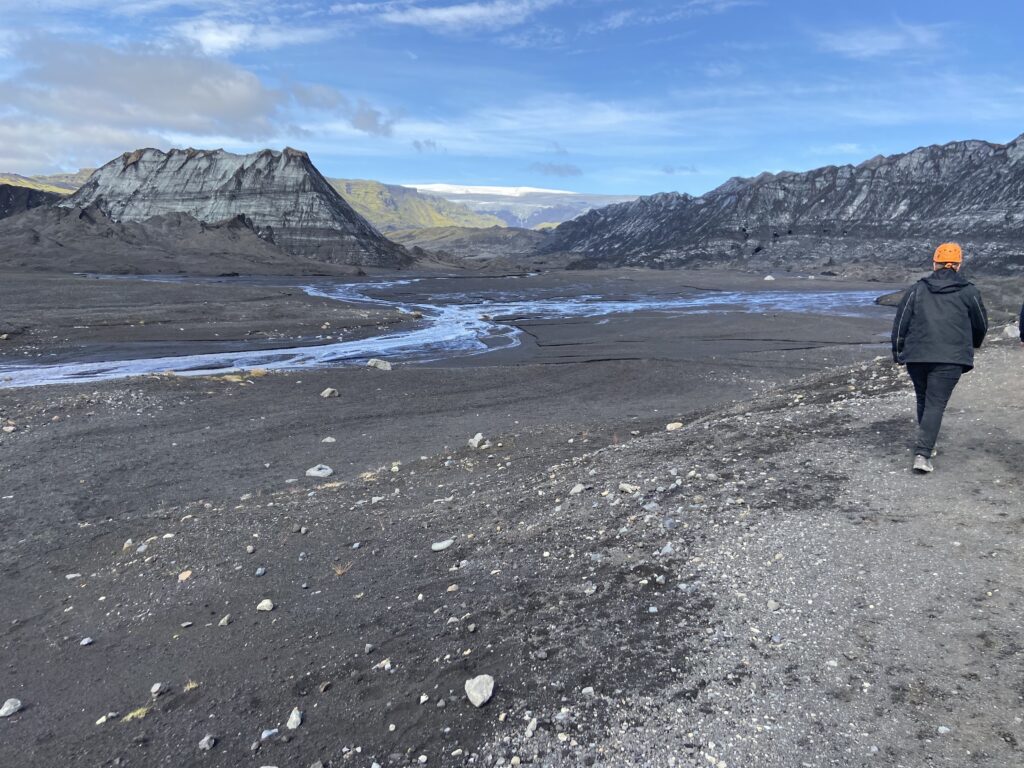
As the guide explained, they’re lucky these days to have a single ice cave last out a whole year. Ice caves are formed as an area on the ice sheet begins to differentially heat – maybe due to an angle of a crevasse, maybe due to some of that black ash, maybe something else. The differential heating on the surface causes that ice to melt deeper sooner as it slowly travels down the mountain. Eventually, in the winter the wind enlarges that gap until the gap reaches all the way through to the next crevasse. And boom, you have yourself an ice cave. As soon as one is mature enough to walk into, the clock is ticking. Wind, summer sun, and meltwater all work their best to continue enlarging the cave until eventually it weathers away entirely. Glaciers are changing on the scales of years and centuries, as I already knew, but this taught me that they also change immensely from day-to-day.
Now we were at the toe of the glacier. What from afar looked like a long, squat sheet of ice now looked like a legitimate series of hills and valleys. Even the very end of this glacier was 50 feet tall if it was an inch. Although given the miniature moraine at the front of it, who knows how far exactly it reached up.
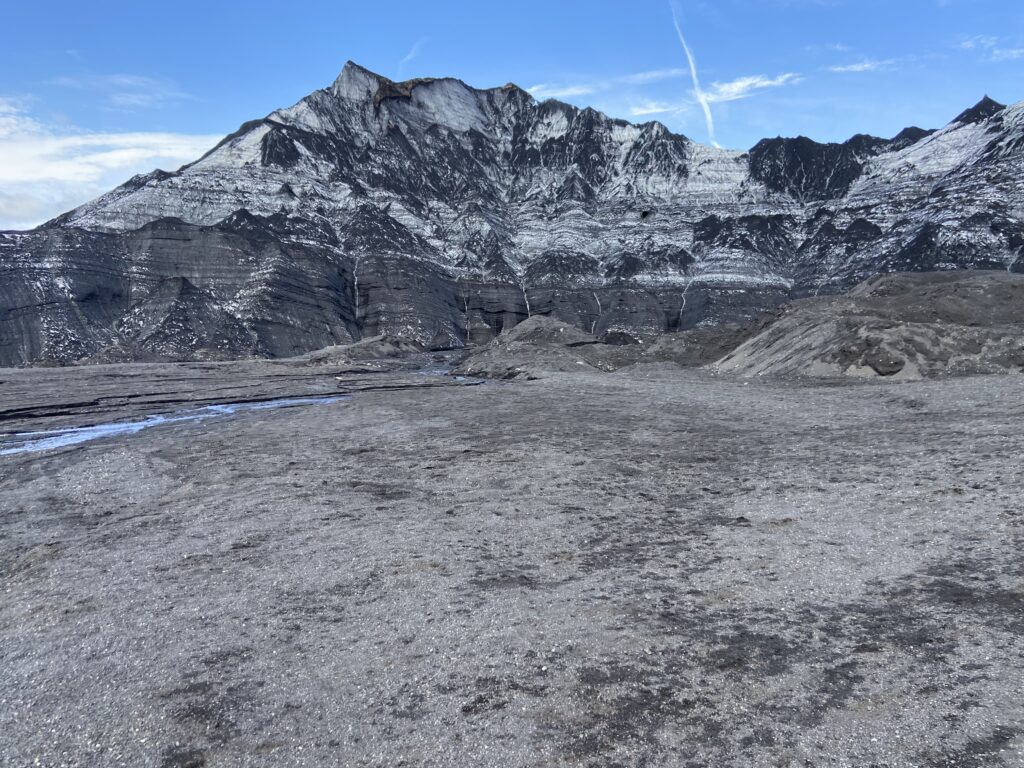
Our guide took a beat at the foot of the glacier so that we could put on microspikes (very necessary to walk on the ice), and get helmets (not really necessary) and ice picks (literally just for show). Now I was an overheated, overdressed tourist holding an ice pick.
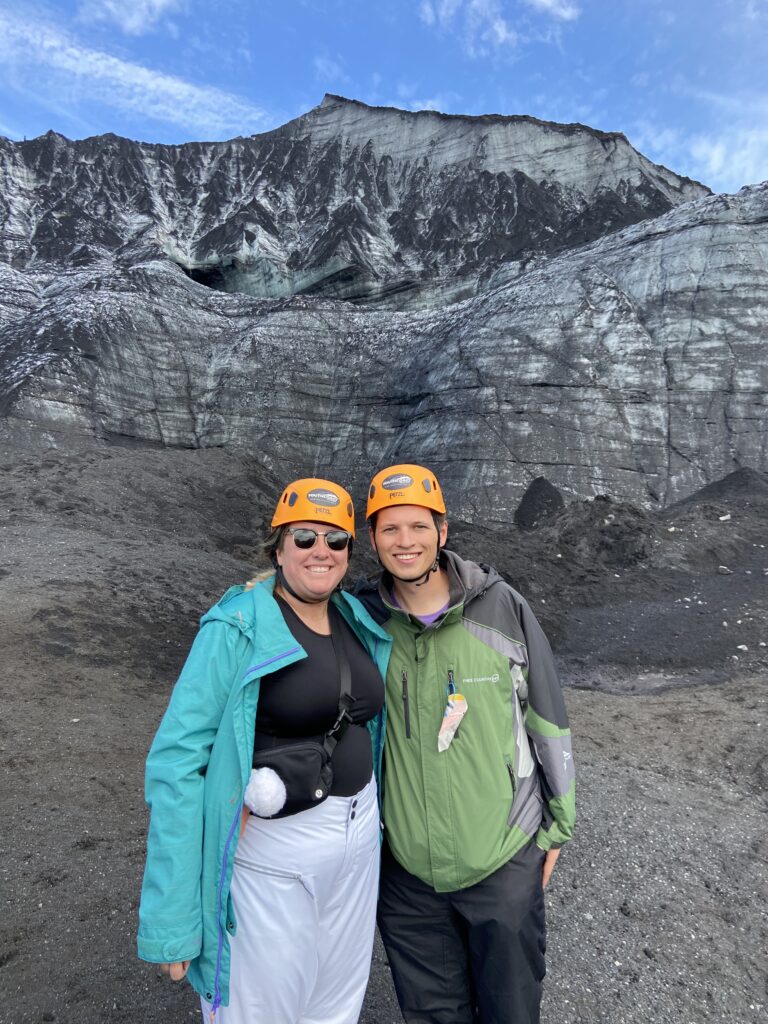
Something else I learned very quickly about a glacier: in addition to constantly changing, it’s loud. Meltwater dripped off of certain spots, sprayed in others, and roared in big gushing rivers at the foot of the glacier. The ice cave itself had one of those rivers exiting it in a series of surprisingly sharp bends, with water that was roughly the color of Scipio’s bathwater when he rolls in something unfortunate on a walk.
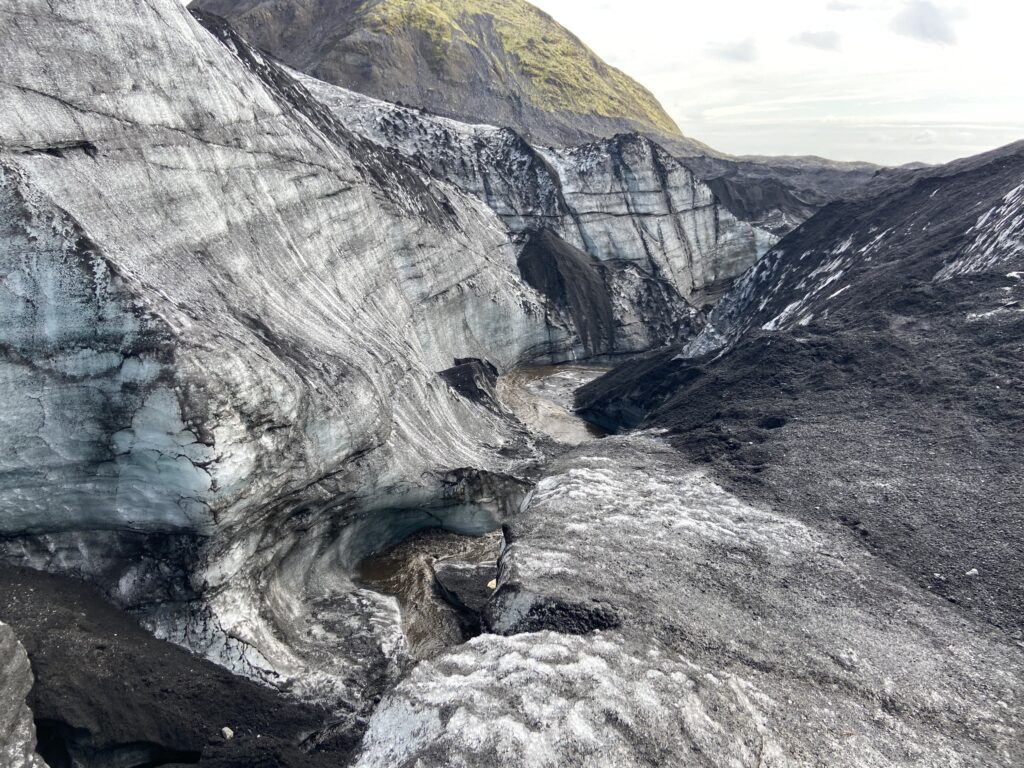
At some point I guess the silty ash had given way to a heavy, crusty snow. So I guess it was official! I was touching my first-ever glacier. Years of obsession with them had finally led to this momentous occasion.
Back the other way, we came around a corner and saw the ice cave for the first time. I think we were “unlucky” so to speak in that we had an ice cave that was in an advanced state of decay. The guide said he hoped it would last them another month, if they were lucky. The upshot was that the cave was large in diameter and short in depth, which I suppose would make it less magical.
But.
Are you going to tell me this isn’t cool as heck?
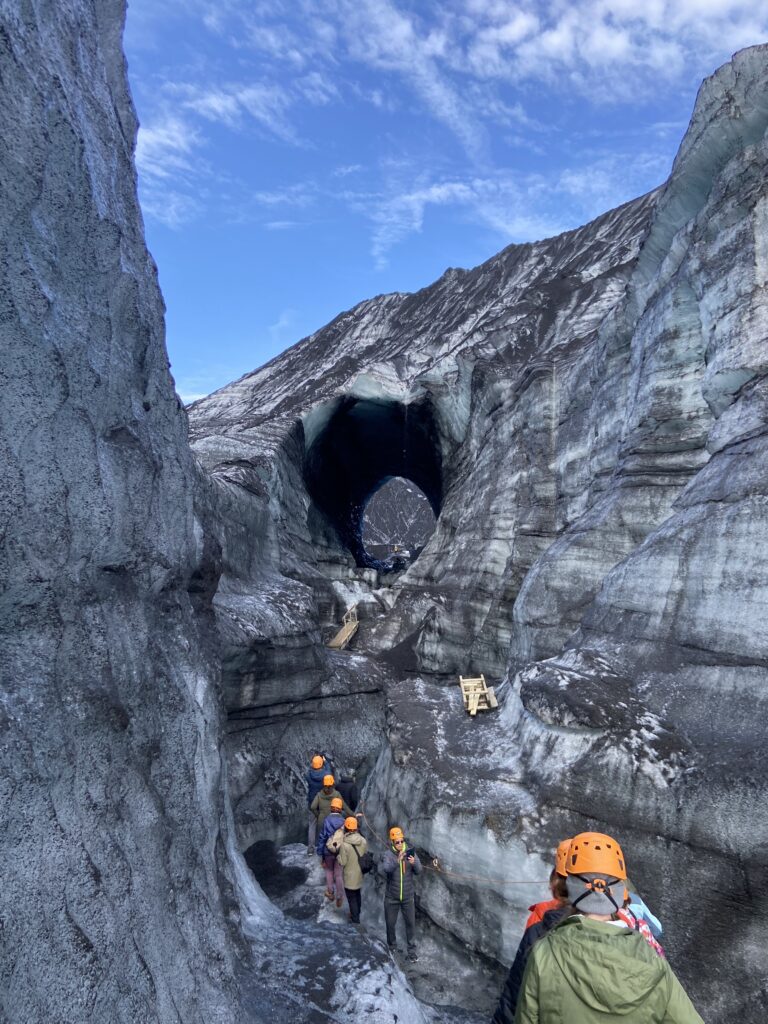
Let me reiterate: glaciers are very tall.

It was pretty cool to see the ash strata from Katla’s past eruptions. The ice provided a bit of geologic history of the island. Meanwhile, please note the extremely fancy path that had been hacked along the side of the outflow. Each tour guide that was leading their little sheep along had an ice pick as well, and unlike the tourists they were using them. A hack here, a hack there – and no, it wasn’t for show. This path constantly has to be updated, which is why the board looked like it was put there yesterday. It probably was. Glaciers are living, breathing, shrinking entities in the summer, alright.
After several more duck-walking corners, we reached the point where the high walls of the ice canyon curved up toward each other. The whole thing reminded me of stained glass, in a weird way. The walls of the cave were much smoother than the melt-pocked exterior – here, you could almost act like there had been no impact of the outer world on the ice. There was a conspicuous blue tint – the tint of all glacial ice inside the caves. It wasn’t the brilliant blue you see sometimes, more of a minty toothpaste mixed with the ever-present ash rings.

And still the guides hacked away, and the water rained down, and the river roared. What a cool and completely unique experience in my life it was. The scariest part was navigating on the wooden planks with microspikes, as they got plenty of purchase in the ice.
On the other end of the ice cave, we came out into a little valley. Big mounds of ash and ice congregated around us in every direction. We were there late enough in the summer that the ash had formed a solid layer on top of melted ice, so you could walk on something that almost felt like an unpaved path deeper into the glacier. And that’s where we were. Literally in the middle of a giant glacier. Nature is so cool.
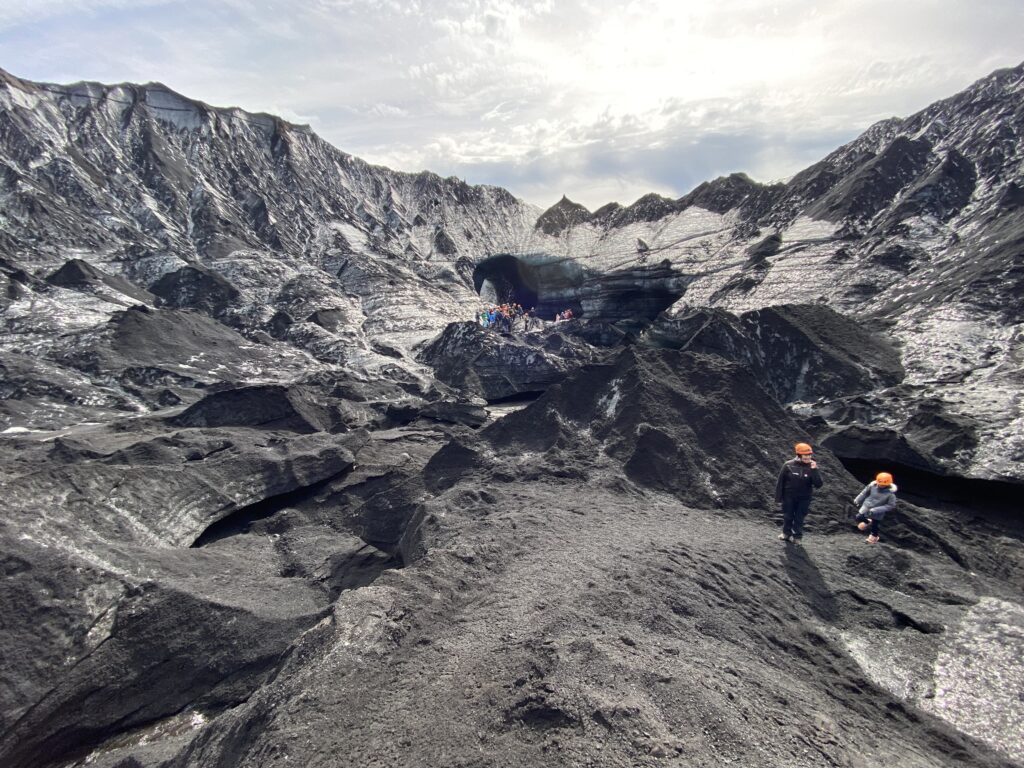
Our guide hacked pieces of ice off of a relatively clean portion of the little hill we were walking up, and handed them to us to eat. One-thousand-year-old snow that has been compressed over centuries into the densest ice you can find on Earth tastes very fresh and pure – maybe 30% better than Chick-Fil-A ice.

On the far side of this valley, which was maybe only 50 yards across, was another mound of ice. There was a hole in the mound about 6 feet across, out of which are raging glacier river poured. I asked the guide, “Will that be your cave next year?” He shrugged an Icelandic shrug, and told me it depended on how much the glacier melted. I could feel the pain exuding from him as he admitted that the country’s precious treasure was slipping away.


But he recovered enough to instruct Elizabeth to do a leg pop when he took our picture in front of the waterfall (picture not on my laptop).
And that’s about as deep into the glacier as our ice cave tour went. I would have loved to have seen a smaller ice cave, or to have seen the ice cave in the winter when it was a little less melty, but life is about what you get, not what you want. It was a beautiful day in a truly alien, foreign landscape of ice. I mean, words can’t describe how weird it was. Elizabeth struck up a conversation with a couple who had also just been to Rocky Mountain National Park and were celebrating an anniversary (but theirs was like 30), which sort of had a weird poetic vibe. I just tried to soak it all in.

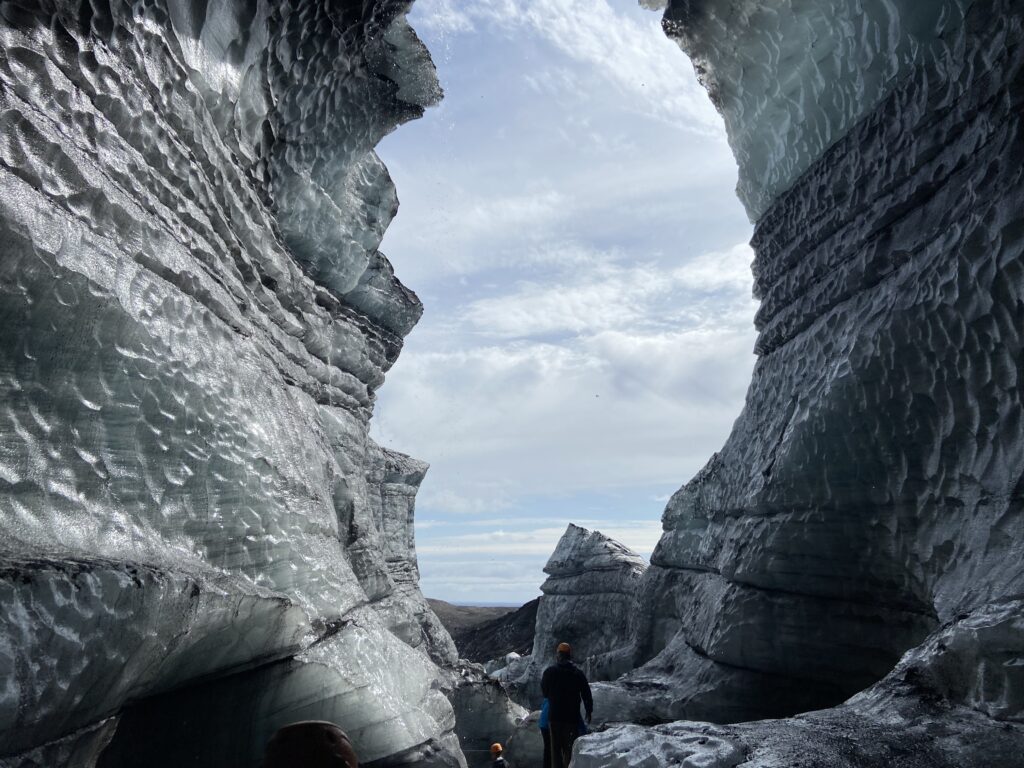
And then once we’d taken our walk back through the cave, it was time to exit Katla Glacier. We had to make another meandering walk back up to the parking lot (each year, the walk gets longer and more annoying!), but fortunately there was a shortcut through the sandy floodplain to get back to the main road for those of us still pinned in the back seat in their way-to-warm winter clothes.
My first glacier experience was one that I’ll have in my memory for the rest of my life. It was so freaking tall, and so *active*, rather than this flat, ponderous ice sheet I imagined. It was here (and immediately afterwards in Vik, eating the best soup I’d ever had) that I knew Elizabeth and I had picked right in going to Iceland for our honeymoon.
